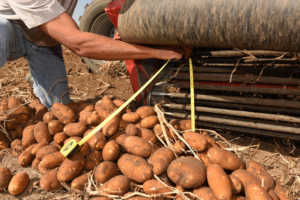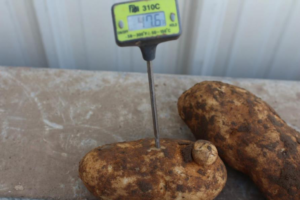Nov 30, 201710 things growers can do to improve quality
At the recent BIG Idaho Potato Harvest Meeting, there was one word that was mentioned over and over again by speakers, “quality.” While the gathering was aimed at Idaho growers, it contained information that can be applied to operations nationwide.

“We can’t rest on our laurels,” said Frank Muir, president of the Idaho Potato Commission (IPC). His message, as well that from other speakers, stressed that since production in the state is up, but not acres under cultivation, that means more and more potatoes are being grown per acre. That increased productivity means that producers have to be more vigilant than ever to prevent black spot and shatter bruise.
“The more successful you are on the demand side, it puts pressure on the quality side, because we are dealing with a product that is greatly contingent on mother nature and on how we handle it,” Muir said.
To that end, the IPC and the Idaho Grower Shippers Association brought in University of Idaho Extension professors Nora Olsen and Mike Thornton to give growers steps they can take to safeguard and improve potato quality on their operations.
The title of that presentation was “The Top 10 List of Potato Quality.”
“Realize this is not a new issue, and that’s the bad news” said Thornton, who is also the Parma chair at U of I. “We’ve been fighting bruise and decay as long as man has been harvesting potatoes.”

After saying that, Thornton followed with the good news, “We know a lot about how to prevent bruise.”
He said while there is new technology, such as impact meters, it’s most important to remember the basics.
The Top 10 List of Potato Quality
1 Avoid large drops – While this may seem obvious, it’s key. There is a safe distance to drop a potato, usually between 5.5 and 11 inches at optimum harvesting temperatures. That means lowering anything with a pivot point, a harvester or piler, to within that safe distance. If that is not possible, then growers should use conveyors to break up a large drop into smaller, safer ones. In addition, match the volume running through a machine with that machine’s capacity. In other words, that means making sure there is not empty chain, meaning if there are no other potatoes there to help break the fall, bruise is more likely to occur.
2 Use cushioning – It’s not the speed at which a potato falls that does damage and causes bruise, rather it’s the force with which it hits a hard object. Cushioned chain and closed-cell foam can go a long way to slowing potatoes down in the final inch before impact. Even folding a piece of belting over can provide enough cushioning to prevent bruise.
3 Know the temperature – As the temperature falls, potatoes become more susceptible to bruise. That means the distance the potato can fall with no damage is also reduced. For example, a potato at a 55-degree pulp temperature might be able to fall 10 inches. If that pulp temperature is reduced by 10 degrees, the allowable drop height is cut in half.
4 Pay attention to soil conditions – A potato harvester moves 420 tons of potatoes per acre, so soil conditions are important. Too dry of soil means it will fall out of the harvester too quickly and it won’t provide cushioning. If the soil is too wet it sticks and, while it initially provides cushioning, gets taken through clod hoppers, star tables and air knives, causing damage further down the line.
5 Educate machine operators – One person who doesn’t know what they are doing can wreak havoc as far as quality. For example, one person an untrained operator on a wind rower can lead to damage on 50 percent of the potatoes going through that machine. Since one weak link can undo all of the work done on an operation to prevent bruise, U of I is currently working on training materials including videos in English and Spanish to help train operators.
6 Don’t store in a vacuum – It’s important to know the pulp temperature and maturity of potatoes going throughout harvest. Knowing the conditions and possible problems of potatoes as they go into storage is key to manage that crop in storage and to know what the best decisions will be.
7 Use physics – You don’t have to be a math whiz to use physics principles to help guide storage decisions. If this is not your forte, contact storage managers or extension agents for advice. The basic principle comes down to the fact that warmer air holds more water. For example, a warm spot in a pile can hold more water, which means that as it cools down condensation can occur.
8 Manage loss – The two major storage losses are from disease and from weight loss. There is always a balancing act between disease control and making sure there is not too much weight loss. Compounding this is that the weeks just after harvest are critical for controlling weight loss and for wound healing.
9 Packing – In packing sheds the same principles in the previous eight steps come back into play, including temperature and drops. Also keep in mind humidity and physics. For example, potatoes can hit their dew point while being poly bagged, which could create condensation and therefore rot problems.
10 Know your weaknesses – Extension agents having a saying, “We can tell you the color of the train that hit you.” That means agents can say what the problem is but not always how it occurred. If they are brought in after a load is refused, then the problem has already progressed quite far. In order to diagnose what specifically happened, the grower needs to be taking measurements and recording them. By doing that they can identify problems before they become severe and extension agents will have the data they need to recommend solutions.
For specific questions, the authors of the presentation can be contacted directly, Nora Olsen ([email protected]) and Mike Thornton ([email protected]). Resources for preventing bruise can also be found at www.uidaho.edu/cals/potatoes/bruise-management.














